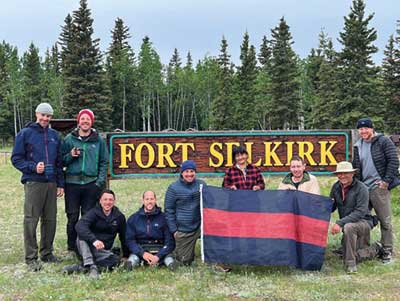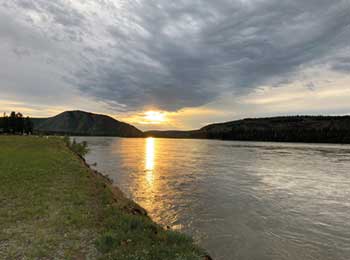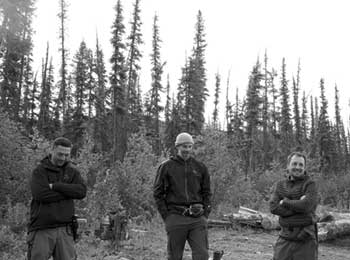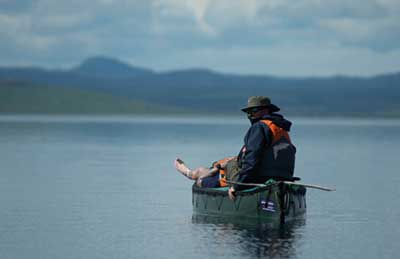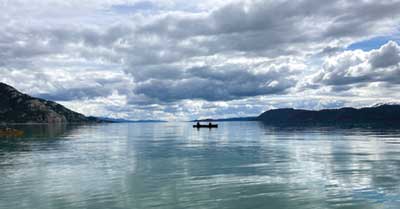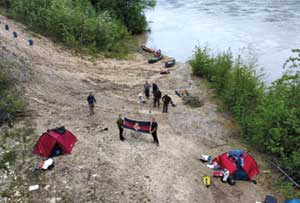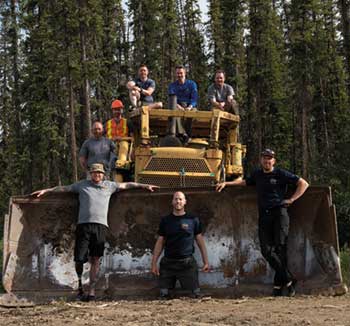|
Home | About Us | Subscribe | Advertise | Other Publications | Diary | Offers | Gallery | More Features | Obituaries | Contact
|
|
|
|
|
|||||||||||
This
is the law of the Yukon, and ever she makes it plain,
 At
midday on 8th June 2022, a team of eight Grenadiers set
off in open canoes from Whitehorse in the Yukon Territory,
Northwest Canada, heading down the River
Yukon. The plan was to get to Dawson City, which is
located about 740 km north, having paddled the whole way
without any support, through one of the world’s last great
wildernesses. What is remarkable about this adventure is
that five members of the team have mental or physical
injuries, sustained
on various operational tours during their service in the
Regiment. At
midday on 8th June 2022, a team of eight Grenadiers set
off in open canoes from Whitehorse in the Yukon Territory,
Northwest Canada, heading down the River
Yukon. The plan was to get to Dawson City, which is
located about 740 km north, having paddled the whole way
without any support, through one of the world’s last great
wildernesses. What is remarkable about this adventure is
that five members of the team have mental or physical
injuries, sustained
on various operational tours during their service in the
Regiment.The expedition was the brainchild of Major Jon Frith (still serving and the team’s only veteran of the Yukon) and Lieutenant Colonel Guy Denison-Smith (who served 1991-2017). It was 18 months in the planning, with the ‘sword of Covid’ hanging over us throughout; we didn’t know until two months out if we could proceed. Then the green light was given and proceed we did; the start date was set for June this year, when usually all Guardsmen are settling down in front of the telly to closely watch and inspect the Trooping the Colour. We didn’t have that luxury! Along
with Jon and Guy, the others in the team were Paul
Richardson (PTSD; served 1984-95), Captain Ben Stephens
(1990-97), Alex Harrison (blindness; 2003-09), Dougie
Adams (PTSD; 2005-14), Captain Garth Banks (double
amputee; 2009-14) and Tony Checkley (single amputee;
2009-15). We ranged in age from 32 to 58 and, between
us, have served on deployments to Northern Ireland,
Bosnia, Iraq and Afghanistan, across 99 years of
service.
Having
completed over 120kms, we established our camp on a
small island in the river, safe from bears and without
vegetation, so it was nearly mosquito free.
However, we soon realised that the river hadn’t
finished rising! With the water level steadily
increasing, it became apparent that we might be washed
away and so we ‘stagged on’ throughout the night, to
ensure that we were not caught out. By 5am it was time
to abandon our much-reduced island and to head off,
whilst we still had time to pack up the camp first.
Leaving
Rita proudly flying a Grenadier flag that we had donated
to her and wearing one of our caps, we bade farewell the
following morning to tackle Day Six. The water level was
still rising as we headed for the junction of the Yukon
and White River. Along the way, we were joined by a
moose who had decided to swim across our path. At this
point the river was at least one kilometre wide; so it
was a truly sensational sight and the noise it made was
also extraordinary. We camped that evening at a place on
the map called ‘Thistle’ finding a navigable exit that
some local gold prospectors had forged into the dense
forest. Many still search for ‘Yukon Gold’, hoping to
make their fortune. For us the evening passed without
incident and we left the following morning, knowing that
we had only 200 kms remaining to cover before we would
reach our final destination.
We
woke on our last morning with 50 kms to go to Dawson
City and were joined for breakfast by several
inquisitive beavers. After packing up our camp for the
last time, the canoes were made ready and we headed off,
arriving at our destination by midday, feeling tired but
elated. The
sense of achievement amongst us was huge. The team had
overcome every obstacle together – every man played his
critical part. For
the briefest of moments it felt like we were all serving
again, working together in a close-knit team, dependant
on one another and only ever having to think about food,
shelter, survival and the task at hand.
Living under the never setting sun, in a vast,
unfamiliar territory with every sense straining to
distinguish if the noises of the wilderness were friend
or foe, we had come out the other side.
We had taken on Mother Nature and learnt to go
with the flow... literally. This was a truly memorable
experience for all of us and it shows that, disabled or
not, together extraordinary things can be achieved. |
|||||||||||
|
|||||||||||

